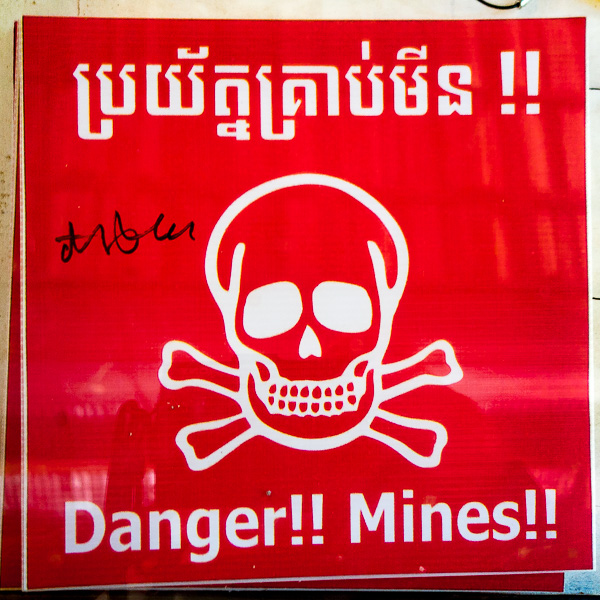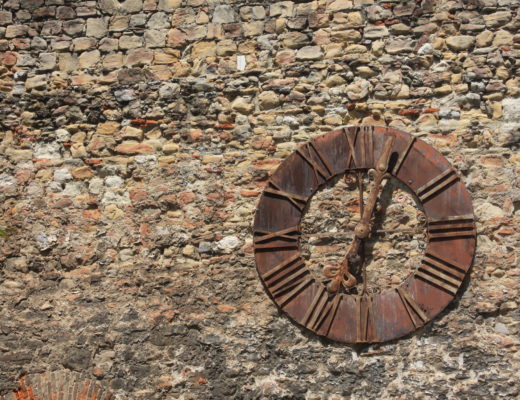“I don’t know what year I was born, but I’m told it was 1970. I was given my first gone [sic] at the age of ten, when I became a child soldier with the Khmer Rouge… I saw many of my friends die during the war as well as many civilians. It was normal to see such things as a soldier in Cambodia.
“I used to lay landmines when I was a soldier. I laid thousands. At the time I did not realize how terrible landmines were or how much pain they caused my people. From childhood to adulthood, all I knew was war. I grew up thinking that was normal. I was very good at using landmines and learned all about them as a soldier. Landmines were my friends because they could catch food for me. They would even protect me when I slept.” – Aki Ra, the founder of the Cambodian Landmine Museum and Cambodian Self Help Demining, an NGO dedicated to removing landmines and unexploded ordinances.
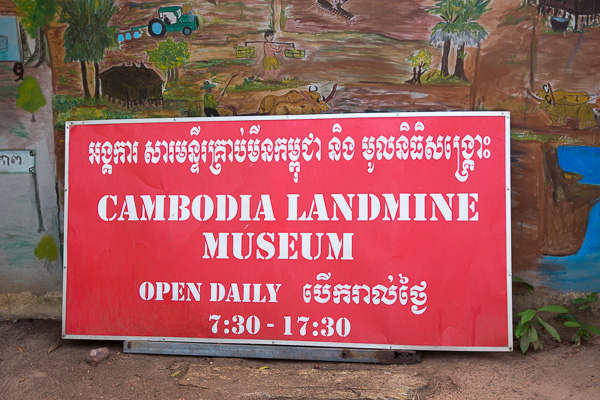
We had taken a break from visiting the Temples of Angkor to stop at the Cambodian Landmine Museum. It is inside the boarders of the Angkor Archaeological Park and was on the way to our next temple, Banteay Srey. We had heard it was a worthy visit, even if you just paid for a ticket and left, with 100 percent of the admission fee being used to fund worthy causes. But, our time in Cambodia wasn’t spent glossing over the tragedies which took place (read more here and here), so we again braced ourselves for what was sure to be an emotional experience.
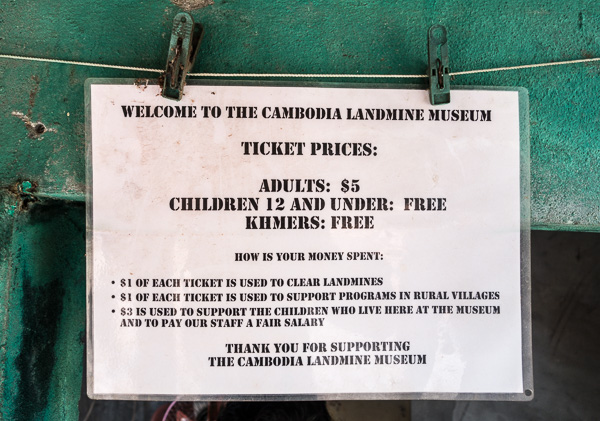
Each dollar used for an important cause.
When we walked in, we were greeted by the words above.
Aki Ra, the founder of the Cambodian Landmine Museum, was made an orphan by the Khmer Rouge and then made a child soldier by the same people who had killed his family. He grew up believing people dying was “normal” and that “landmines were…friends.”

A recent photo of Aki Ra. Photo from Cambodian Self Help Demining.
There was no skirting around it, we were in for another tough tour.
At the museum we learned about the two different types of landmines found in Cambodia, Anti-personnel mines (AP), geared towards hurting or killing individual humans, and Anti-tank mines (AT) to blow up vehicles. There are two types of AP mines in Cambodia, blast mines which are built to injure and maim, and fragmentation mines designed to kill. Most of the mines in Cambodia are blast mines.
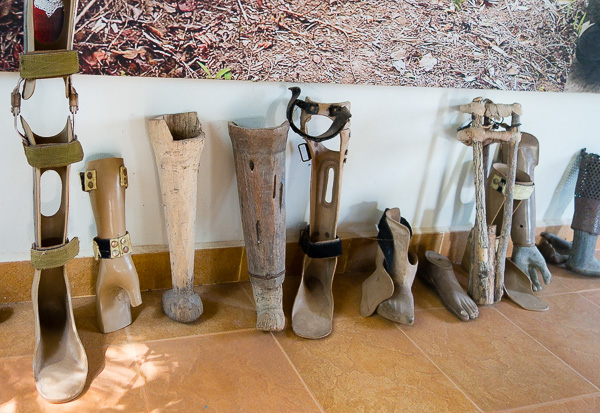
The very real impact of landmines in Cambodia. We saw prosthetic legs and arms made out of bamboo, branches, wood, plastic, and many other items. Although, most victims of landmines that we saw during our time in Cambodia didn’t wear prosthetics.
The reason for the abundance of blast mines was repeated several times in our audio tour and posted around the museum as well; “If you kill a soldier you have to bury him. If you wound him, you have to care for him. You force your enemy to spend more money and resources on wounded people than dead ones.”
Horrible.
But Cambodia isn’t only dealing with landmines. They also have millions of unexploded ordnance (UXO), which are bombs, rockets, missiles, mortars and grenades which did not explode when they were used and still pose a risk.
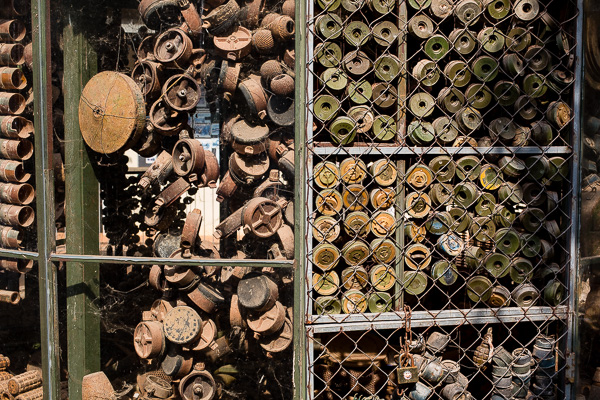
Some of the UXOs and landmines that Aki Ra has removed and disarmed.
So how did they get here?
As I hinted at in my previous posts about the Khmer Rouge, Cambodia has a tumultuous history. A civil war from 1967-1975 led up to the Khmer Rouge coming into power from 1975-1979 and then a 20 year guerrilla war followed the overthrow of the Khmer Rouge.
While there was fighting taking place between the citizens of Cambodia, there was also the impact of Cambodia’s neighbors. Vietnam boarders a large portion of Cambodia and, as a result, Cambodia was carpet bombed for years by the US during the Vietnam War.
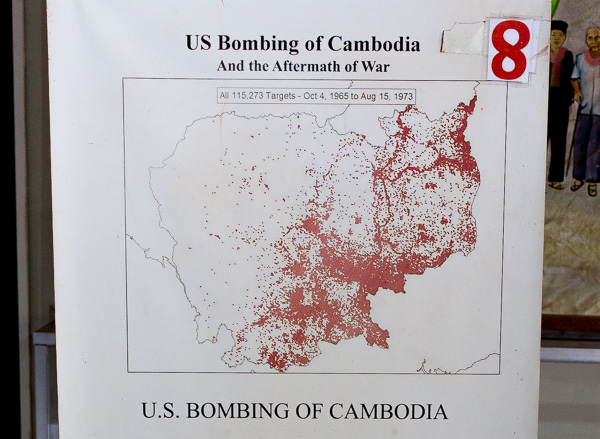
Each red dot marks a target that was bombed. More than 115,000 targets are shown.
According to the Landmine Museum, many of the mines in Cambodia were laid during the Vietnam War along the Cambodian boarder and during the guerrilla war along the Thai boarder, while millions of UXO’s were dropped on Cambodia during the 60’s and 70s by the US.
Aki Ra was right in the heart of it as one of the Khmer Rouge soldiers planting those landmines.
However, in 1987 he defected and became a soldier in the Vietnamese Army. The Vietnamese military had been present in Cambodia since they helped to overthrow Pol Pot’s Khmer Rouge in 1979. They withdrew ten years later in 1989 and Aki Ra continued to fight against the Khmer Rouge with the Cambodian National Army. In the early 1990s Aki Ra worked with the United Nations and was trained as a deminer and learned to clear landmines and UXOs.
He put that knowledge immediately into practice and started clearing landmines and UXOs with a stick and a knife. He cleared tens of thousands, some of which he had planted as a child, using that dangerous strategy before he was sent to the UK to learn a safer way to disarm the explosives at a special explosive disposal school.
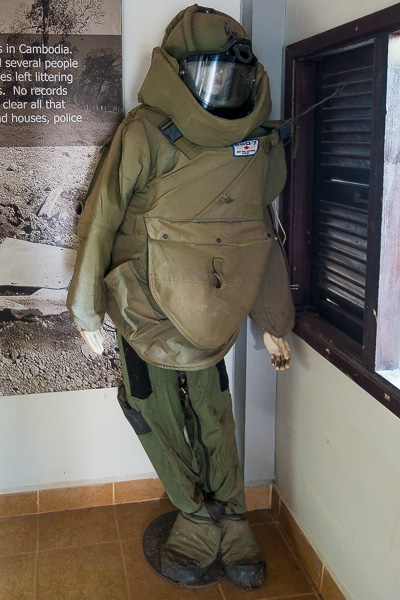
The protective suit that Aki Ra and his team wear to remove the mines and UXOs.
Some of the mines and UXOs he has disarmed are on display in the museum. The entrance is lined with huge bombs dropped by the US and the museum’s focal point is a cage in the middle of a small water feature filled with thousands of different explosives which have been removed and disarmed by Aki Ra.
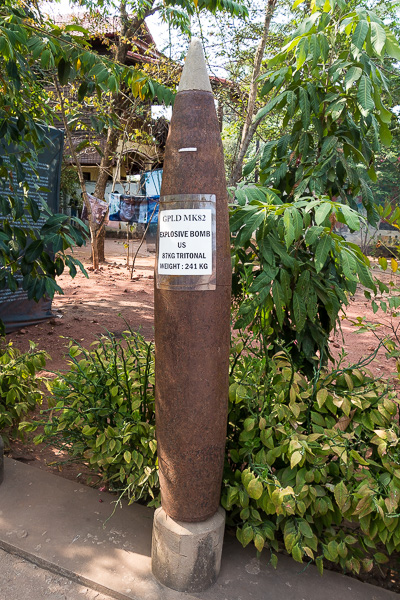
One of the bombs that line the path into the museum.
Yet, while the rooms at the museum are full of disheartening stories and despair, we couldn’t overlook the growth that has come out of Aki Ra’s terrible story.
In the late 1990s, Aki Ra, along with his late wife Hourt, noticed a majority of those affected by landmines were children who were playing in fields or near their schools. In order to combat this, they started a Relief Center, which is attached to the museum. It is an orphanage of sorts which originally housed approximately two dozen children who were landmine victims. Aki Ra and Hourt raised the children as their own and provided them with an education.

Aki Ra, center, and a group of children injured by landmines. Photo from the Cambodian Landmine Museum website.
Today, the Relief Center remains a home for two dozen children, but none of them are landmine survivors; instead they have other injuries, are handicapped, orphaned, and/or poor. A majority of the $5 museum entry fee goes to help fund the Relief Center.
Aki Ra has also created his own NGO, Cambodian Self Help Demining, where he now has a staff of more than two dozen deminers and they focus on clearing “low priority” villages in Cambodia. He defines low priority as hard to get to places with low populations. Since their inception they have cleared 122 landmine fields stretching 2,938,409.5 square meters.

A photo from the Cambodian Self Help Demining website showing the team of people who work with Aki Ra to rid Cambodia of explosives.
But they still have a lot of work to do.
It is estimated that there are between 4,000,000 and 6,000,000 explosives still buried in Cambodia today. According to the latest numbers out from the Cambodia Mine/UXO Victim Information System in 2016 there were 72 accidents involving mines and UXOs which was down three percent from 2015 and 83 deaths involving mines and UXOs, down 25 percent from 2015.
Still, Cambodia remains one of the most affected countries in the world by landmines and UXOs. One out of every 290 Cambodians are amputees. Since the data has been collected by the Cambodian Mine Action and Victim Assistance Authority (CMAA) in 1979, 64,662 Cambodians have been killed by mines and UXOs.
I think Aki Ra put it best when he said, “This problem will not go away until we all decide to make that happen.”
Currently there are still a handful of countries making landmines and places of conflict such as Syria, Sudan, and Iraq are being filled with landmines right now.
If you want to help, visit these sites to learn more and donate.
Cambodia Landmine Museum and Relief Center
Cambodia Self Help Demining – Aki Ra’s NGO
Landmine Relief Fund – A fund set up to help support Aki Ra’s NGO
